Addis Ababa Travel Guide
Often considered the gateway to Africa, Addis Ababa is a riotous capital of over three million people, and a must for travellers who want to get off the beaten track. Those who visit will discover a medley of distinct religious and linguistic groups, along with the best Ethiopian food in the country.
The city was founded in the late 1800s by Ethiopian Emperor Menelik II and was later occupied by the Italians during the Second Italo-Abyssinian War. Once the Italians had been ejected, Emperor Haile Selassie immediately set about rebuilding the capital and formed the Organisation of African Unity. That intergovernmental organisation was replaced by today's African Union, which still has its headquarters in this proud African city.
Addis Ababa is home to the world-renowned early hominid, Lucy, whose skeleton is housed in the Ethiopian National Museum. Visitors will also find several interesting mosques and cathedrals, Menelik's old Imperial Palace, which is the official seat of the Ethiopian government, and one of the largest open air markets in Africa.
Tourists who want to buy souvenirs of their stay in Ethiopia should look into getting a pack of Ethiopian coffee beans, preferably vacuum-sealed to preserve freshness. Decorative metalwork in the form of crosses and painted religious artworks on carved wooden boards are popular, too, as are filigreed silver and gold jewellery. Foodies will relish the local cuisine, which is inventive and flavourful; tibs (sliced beef or lamb pan-fried in butter, garlic and onion), kitfo (similar to French steak tartare), and fuul (a mix of stewed and spiced fava beans eaten by many Ethiopians for breakfast) are among the best dishes.
Most travellers merely pass through Addis as it's the main transport hub of the country, but this transit shouldn't be rushed. Rather, it's a good two-day tourist city, offering travellers an authentic taste of urban Africa, with all its complexity, contradictions and dynamism, and enough interesting attractions to make a decent sightseeing itinerary.
Things to do in Addis Ababa
There's plenty to see and do in Addis Ababa, and the journey to the attractions is frequently as interesting as the sights themselves. This is particularly the case should visitors choose to walk the city and navigate their way to the main museums and buildings.
It's a good idea for visitors to hire a taxi driver for a daily fee and have him drive them around. Those who choose to rely on maps and GPS should note that roads frequently change names. Travellers should be aware of scams that involve 'cultural shows' that take place in backstreet venues. If visitors do wish to see traditional dancing and music, they should simply dine at any decent and reputable restaurant where such attractions are provided free.
As for mainstream attractions in Addis Ababa, travellers shouldn't miss paying Lucy a visit at the National Museum, doing a bit of shopping at the Merkato (one of the largest markets in Africa), seeing the wonderful cultural artefacts in the Ethnological Museum, and studying relics of the city's past in the Addis Ababa Museum. It's also worth keeping their eyes open for the numerous concrete Soviet statues and buildings that dot the city.
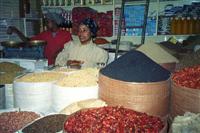
Mercato
The Mercato is one of the largest outdoor markets in Africa and Addis Ababa's most colourful sight. Ideal for souvenirs, there are tailors, spice merchants, and purveyors of just about every commodity under the sun, including wonderful Ethiopian coffee. Mercato is memorable but not for the faint hearted, given its wandering animals, hollering vendors, and riot of colour, aromas, and sensations. The spice market is particularly interesting, with its exotic colours and smells. The Mercato is a pick-pocketing hotspot so visitors should be careful with their valuables. It's best to wear a money belt under clothes rather than keeping cash in an accessible place. Shoppers should bargain hard as prices are enormously flexible and foreigners are routinely charged three to four times the going rate.
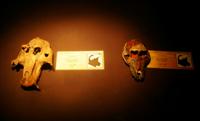
National Museum of Ethiopia
This museum displays a varied range of exhibits across three floors, and they cover Ethiopian history from the prehistoric to the contemporary. The museum is not world-class in terms of its facilities or exhibition space, but it does contain some genuinely fascinating artefacts and gives visitors a good historical overview of Ethiopia. The most famous exhibit is the replica statue of Lucy, thought to be the oldest hominid skeleton ever found and estimated to be 3.18 million years old. Lucy was discovered in 1974 and named for the Beatles song. The fragile original skeleton is in the vaults of the building. Also of interest is the selection of celebrated Ethiopian artworks from Axum, Lalibella, and the Tana Monasteries, as well as relics from Haile Selassie's reign.
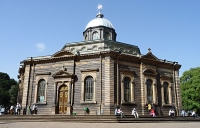
St George's Cathedral
St George's Cathedral was founded by the great Emperor Menelik to commemorate his 1896 victory over the invading Italian army. A relic of St George was carried into battle by the Ethiopians and the emperor built the cathedral to pay tribute to the saint that ensured his victory. The cathedral is a holy place of pilgrimage for Rastafarians. It has a traditional Ethiopian design and octagonal shape, and the outer walls of the building are covered in wonderful artwork and mosaics, including work by Afewerk Tekle, one of Ethiopia's most celebrated artists. Inside, beautiful stained-glass windows enhance the sacred atmosphere. In 1930, the church hosted the coronation of Emperor Haile Selassie and he and Empress Menen are two of the famous Ethiopians buried here.
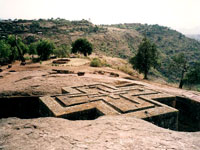
Lalibela
Lalibela is one of the world's most remarkable spiritual sites and Ethiopia's greatest tourist attraction. It's home to the country's astounding rock-hewn churches and is an important pilgrimage site for Ethiopia's Orthodox Christians. There are 11 functioning churches in total, all carved from a single piece of granite. The churches were carved from the top down and some lie nearly hidden in deep trenches, while others stand in open caves. Each is unique. The churches are connected by a labyrinth of tunnels and dark narrow passageways with crypts, grottos, caverns, and galleries hewn from the red rock. They were carved between the 10th and 12th centuries in a bid to create a New Jerusalem for those unable to pilgrimage to the Holy Land.
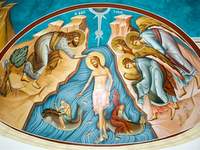
Axum
Axum is a city in far northern Ethiopia. Its 17th-century Church of St Mary of Zion is said to house the Ark of the Covenant, which visitors aren't permitted to see. Colossal stone obelisks dating back to 300 AD are remnants of the Kingdom of Aksum and are recognised as remarkable historical artefacts by UNESCO. In 2005 one such obelisk was returned to Ethiopia with great fanfare after having been looted by Italy in the early 20th century. The largest number of these impressive sculptures is in the Northern Stelae Park, and the tallest one that remains standing is King Ezana's Stele, which is over 78 feet (24m) tall and weighs 160 tonnes. Some tombs have been excavated under the giant stele, but archaeologists have not yet explored the vast majority of this fascinating underground world, and the extent of the mysteries the obelisks guard is unknown.
Harar
Harar is a fascinating, exotic town of considerable interest to visitors willing to make the 320-mile (520km) journey east from Addis Ababa. Harar is the fourth holiest city in Islam and was forbidden to outsiders until 1887, when it became part of the Ethiopian Empire. Harar boasts about 82 mosques (three from the 10th century) and 102 shrines. The city is perched on the eastern wall of the Great Rift Valley, affording it a cool climate and wonderful views of the soaring mountains to the east. The main attractions are inside the Walled City, a fascinating warren of medieval mosques, houses, and markets. Another popular attraction is the nocturnal Hyena Man, who feeds wild hyenas strips of raw meat suspended from his mouth and sticks.
Bahir Dar
Bahir Dar is one of the most popular tourist destinations in Ethiopia. Known for its palm-lined avenues, it sits at the southern edge of Lake Tana, which is the source of the Blue Nile. The town is the main base for visiting Tissisat Falls and the lake's 37 islands with their ancient churches and monasteries. Unfortunately, many of these churches deny access to women but there are exceptions. The lake is enormous and it will probably take half a day just to visit two or three of the monasteries. The scenery is beautiful, though, and visitors may even spot some local fishermen in traditional papyrus canoes or groups of hippo. The most beautiful of the monasteries on Lake Tana are Debre Kebran Gabriel, which dates from the 14th century, and Ura Kidane Mehret, which has exceptional frescoes.
Gondar
Scattered with ancient castles and churches, and magnificent mountain scenery, Gondar is a city like no other. This pleasantly cool destination lies 460 miles (748km) north of Addis Ababa and is the next clockwise step after Bahir Dar on the official Historic Route through Ethiopia. Founded by Emperor Fasilides around the year 1635, Gondar grew as an agricultural centre and market town, and was the capital of Ethiopia for hundreds of years, which would account for the numerous castles. The oldest and most architecturally interesting is the Castle of Fasilides, which has Axumite, Portuguese, and Indian elements. Near the edge of Gondar is the Church of Debre Birhan Selassie, which was built in the 17th century and contains the country's most celebrated ceiling murals. Gondar is also a natural base for treks into the Simien Mountains and many tour companies tout their services in the city.
Getting Around
A large and efficient network of blue and white minibuses covers the city of Addis Ababa. These minibuses are easy to hail from the side of the road, though it's worth having an Ethiopian guide along if it's a tourist's first time using these taxis. Small blue taxis are more expensive. Negotiation is the norm and foreigners often have to press quite hard to get a bargain. These taxis can be contracted for a full day after some negotiation.
There aren't many road names and they often don't match the ones written on maps, so it's best to navigate by using landmarks. Churchill Avenue is the main thoroughfare and shopping street in Addis Ababa.
Car hire can be organised through international agencies in the city, and a fully valid international licence is required. The licence from a traveller's country of origin must also be endorsed locally and the driver must be a minimum of 18 years old. It's a good idea to hire a car and a driver if visitors plan to travel extensively. Vehicle travel outside the city after dark can be risky.
Autobus Terra, near Mercato, is where most of the national buses arrive and depart and it's the main bus terminal. The only working railway line runs between Addis Ababa and Djibouti, via Dire Dawa and Harar. Travellers should be prepared for occasional delays. The Ethiopian ride-hailing app, ZayRide, is another option; walking is still the preferred method of transport around the city.
Addis Ababa Climate and Weather
Addis Ababa has a subtropical highland climate, which means the temperature stays relatively constant, hovering between 46ºF (8ºC) and 77ºF (25ºC) for most of the year. The rainy season lasts from June to September, with July and August being the wettest time of year, when each month receives around 27 days of significant rainfall. These are also the coolest months. The best time to visit Addis Ababa is from October to February, when the temperatures are warm and the days are sunny.
Ethiopia travel info
Electricity
Electrical current is 220 volts, 50Hz. Two-pin plugs are used. Even in Addis Ababa, electricity supply is irregular and blackouts are common.
Language
Amharic is the official language, though over 80 local languages are also spoken. English, Arabic, French and Italian are as well.
Money
The official currency is the Ethiopian birr (ETB), which is divided into 100 cents, and foreign currency can be exchanged at banks and authorised hotels. Only major establishments accept credit cards in Addis Ababa, and credit cards have even more limited usage outside the capital. Visitors should carry hard currency with them, preferably in US dollars. ATMs are sparse, but banks are usually open every day except Sundays from 8am to 11am and 1pm till 4pm.
Tipping
Tourist hotels and restaurants usually add a 10 percent service charge to the bill, but tipping is still fairly common, though only small amounts are customary.
Health
Travellers to Ethiopia are recommended to have hepatitis A, hepatitis B, meningococcus, and cholera vaccinations. There's a risk of yellow fever and proof of vaccination is required if visitors are arriving from a country with a risk of yellow fever transmission or have transited through an airport of a country where yellow fever occurs.
Malaria is prevalent in the lowlands and altitude sickness may affect travellers to the highland areas, including Addis Ababa. Bilharzia is present in many of the lakes and travellers are advised to drink boiled or bottled water, as waterborne diseases are prevalent. A rabies vaccination is recommended for anyone who will be spending a lot of time in wilderness areas or around animals, and a polio booster is recommended for adults who had the vaccine as children.
Medical facilities are poor outside of Addis Ababa, while in the capital, hospitals are available but medical supplies are erratic. Visitors should bring their own regular medications with them and arrange comprehensive travel insurance.
Safety
Petty crime, such as pickpocketing, can occur in crowded areas and, though rare in Addis Ababa, there's a risk of violent crime as well. Travellers should pay close attention to their belongings and avoid walking at night.
Poorly maintained roads and erratic driving affect road safety; visitors should avoid driving after dark, keep their tanks full when in remote areas, and advise a relative of their anticipated itinerary and route.
Credit card and ATM fraud may sometimes occur, so travellers should pay careful attention when their cards are being handled by others. They should also check for any unauthorised transactions on their account statements.
It's crucial that visitors stay updated on local conditions and adhere to travel advisories, as political instability and regional conflicts can pose risks. This is particularly true in areas such as Tigray and parts of Oromia, but also in Amhara and Afar.
Demonstrations take place regularly, especially across the Oromia region and Addis Ababa. They can occur without warning and even peaceful demonstrations can turn violent at any time. Travellers should avoid areas where demonstrations and large gatherings are taking place, follow the instructions of local authorities, and monitor local media for information on ongoing demonstrations. There is a threat of terrorism.
Flooding often affects Ethiopia between June and September each year, with flash floods sometimes killing hundreds of people in low-lying areas.
Local customs
The Ethiopian Highlands are mainly Orthodox Christian and restaurants do not serve meat dishes on Wednesdays, Fridays, and during Lent. The Ethiopian calendar, which is similar to the Julian calendar, consists of 13 months (12 months of 30 days, and a thirteenth month of five or six days). Homosexuality is illegal in Ethiopia, and carries penalties of between 1 and 15 years imprisonment. Shoes should be removed before entering mosques and churches; photographs should not be taken of military buildings and airports, and permission should be asked before photographing religious festivals and people.
Doing business
Etiquette is very important in Ethiopia, both socially and in business. Formal attire is expected of men and women; greetings are very important and the shaking of hands is the norm for first meetings. Ethiopians like to establish good relations with one another and personal relationships are the cornerstone of business.
Businessmen in Addis Ababa understand some English, and perhaps some French and Italian. Ethiopians also respect their elders, so visitors should show the same courtesy. Business hours are generally 8.30am to 5.30pm Monday to Friday, with an hour taken at lunch, though this may vary from business to business.
Duty free
Travellers to Ethiopia over the age of 18 years do not have to pay customs duty on 400 cigarettes or 250g of tobacco; 2 litre of alcoholic beverages; 2 bottles or 600ml of perfume.
Communications
The international dialling code for Ethiopia is +251 and the outgoing code is 00, followed by the relevant country code (e.g. 0027 for South Africa). Internet services are increasingly available and travellers can purchase prepaid SIM cards for unlocked phones.
Passport & Visa
All visitors must obtain an eVisa or get a visa from the Ethiopian Embassy closest to their place of legal residence before travelling. E-visas can be obtained before departure online at www.evisa.gov.et/. A yellow fever vaccination certificate is required to enter Ethiopia if visitors are arriving from a country with a risk of yellow fever transmission or have transited through an airport of a country where yellow fever occurs. It is highly recommended that travellers' passports have at least six months' validity remaining after the intended date of departure from their travel destination. Immigration officials often apply different rules to those stated by travel agents and official sources.
Entry requirements
US citizens must have a passport that is valid for six months after their date of departure from Ethiopia. A visa is required and can be obtained online for those travelling as tourists and arriving at Addis Ababa.
British citizens require a passport that is valid for six months from the date they expect to leave Ethiopia. A visa is required and can be obtained online for those travelling as tourists and arriving at one of the main airports.
Canadian citizens must have a passport that is valid for six months beyond the date they expect to leave Ethiopia. A visa is required and can be obtained online for those travelling as tourists and arriving at Addis Ababa.
Australian citizens must have a passport that is valid for six months beyond the date they expect to leave Ethiopia. A visa is required and can be obtained online for those travelling as tourists and arriving at Addis Ababa.
South African citizens must have a passport that is valid for six months beyond the date they expect to leave Ethiopia. A visa is required and can be obtained online for those travelling as tourists and arriving at Addis Ababa.
Irish citizens must have a passport that is valid for six months beyond the date they expect to leave Ethiopia. A visa is required and can be obtained online for those travelling as tourists and arriving at Addis Ababa.
New Zealand citizens must have a passport that is valid for six months beyond the date they expect to leave Ethiopia. A visa is required and can be obtained online for those travelling as tourists and arriving at Addis Ababa.
Useful contacts
Ethiopian Tourism Organisation: www.ethioembassy.org.uk/visit-ethiopia/
991 (fire and rescue services, medical emergencies, police).


